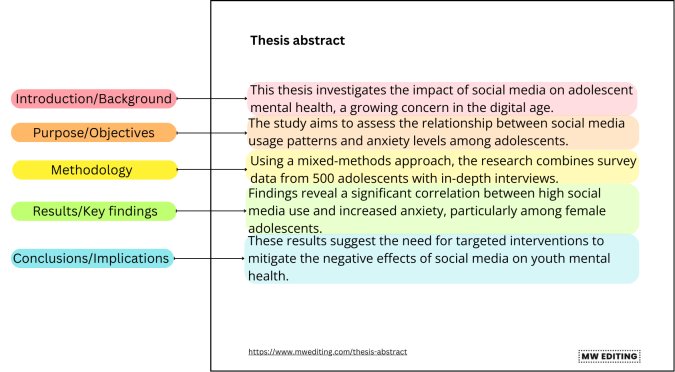A thesis abstract is a brief summary of the thesis or dissertation, typically around 150–300 words. It provides a concise overview of the research, including the key objectives, methodology, findings and conclusions enclosed in the thesis. The abstract allows readers to quickly understand the main points of the academic work and decide if it is relevant to their interests or research.
This blog post will explore the structure, purpose and practical tips for writing a compelling thesis abstract. It will also provide sample abstracts to illustrate these principles in action.
- Key elements of a thesis abstract
- Importance of a thesis abstract
- Structure of a thesis abstract
- Sample thesis abstracts
- Thesis abstract resources
- Finalising thesis abstract with editing services
Key elements of a thesis abstract
- Purpose/Objectives: Clearly state the main research question or objective of your study.
- Methodology: Briefly describe the research methods or approaches you used to conduct the study.
- Results/Findings: Summarise the key findings or results of your research.
- Conclusions/Implications: Outline the main conclusions and the significance (implications) of your findings.
The abstract should be concise, focused and written in a way that is accessible to a broad audience, even those outside the specific field of study. It is often the first section of the thesis that readers encounter, so it should effectively communicate the essence of the research.
Why is an abstract important in a thesis?
An abstract is important in a thesis for several key reasons:
- Provides a summary: The abstract offers a concise summary of the entire thesis, giving readers a quick overview of the research objectives, methodology, key findings and conclusions. This allows them to understand the essence of the work without reading the full document.
- Creates first impression: The abstract is often the first section that potential readers or evaluators encounter. A well-written abstract can create a positive first impression, encouraging them to engage with the rest of the thesis.
- Helps in decision-making: Readers, including scholars, researchers and academic reviewers, use the abstract to decide whether the thesis is relevant to their interests or research needs. It helps them quickly assess the value and applicability of your work.
- Facilitates indexing and retrieval: Abstracts are often included in academic databases and search engines, where they play a crucial role in helping others find the thesis. A clear, well-crafted abstract with appropriate keywords increases the visibility and accessibility of the research.
- Summarises complex research: For complex or technical research, the abstract distils the main points into a concise format that is easier for a broader audience to understand.
- Guides the reader: The abstract sets expectations for the content and structure of the thesis and helps readers navigate the document more effectively.
How to structure a thesis abstract?
Structuring a thesis abstract effectively is crucial to ensure it conveys the essential elements of the research in a clear and concise manner. Here is a typical structure for a thesis abstract:
1. Introduction/Background briefly introduces the topic or research problem the thesis addresses. In other words, it provides context to help the reader understand the importance of the study.
2. Purpose/Objectives clearly state the main objectives or research questions of the study. In answers the following questions: What is the central focus of the research?
3. Methodology describes the research methods or approaches used to conduct the study. This could include the research design, data collection techniques and analysis methods.
4. Results/Key findings summarise the most important findings or results of the research. This section highlights the key data points or discoveries that answer the research questions.
5. Conclusions/Implications outline the main conclusions drawn from the findings. This part discusses the significance of the results and how they contribute to the field or solve the research problem.

Tips for writing a thesis abstract
- Keep it concise: The abstract should be between 150–300 words.
- Be specific: Avoid vague language; focus on clear and direct statements.
- Write last: Write the abstract after completing your thesis to ensure it accurately reflects the content.
- Use keywords: Include important terms to improve searchability and relevance.
5 sample thesis abstracts
Here are 5 examples of thesis abstracts across different academic fields:
Psychology
Title: The Impact of Mindfulness-Based Stress Reduction on Anxiety and Depression in College Students
Abstract: This study explores the effectiveness of Mindfulness-Based Stress Reduction (MBSR) in reducing anxiety and depression among college students. Using a quasi-experimental design, 100 participants were divided into an MBSR intervention group and a control group. The intervention group attended eight weekly mindfulness sessions, while the control group received no treatment. Pre- and post-intervention assessments using the Beck Anxiety Inventory and Beck Depression Inventory revealed significant reductions in anxiety and depression levels among the MBSR group compared to the control group. These findings suggest that MBSR may be an effective intervention for managing mental health issues in college populations.
Engineering
Title: Optimising Solar Panel Efficiency through Advanced Photovoltaic Materials
Abstract: This thesis investigates the enhancement of solar panel efficiency using advanced photovoltaic materials, including perovskite and organic photovoltaics. A comparative analysis of traditional silicon-based solar cells and new materials was conducted using both simulation and experimental data. Results indicate that perovskite solar cells achieved a 20% increase in efficiency under standard test conditions compared to silicon cells. The study also examines the stability and degradation rates of these materials, highlighting the challenges and potential of integrating advanced photovoltaics into commercial solar technology. The findings contribute to the development of more efficient and cost-effective solar energy solutions.
Economics
Title: The Effects of Minimum Wage Increases on Small Business Employment: A Regional Analysis
Abstract: This research examines the impact of minimum wage increases on small business employment across various regions in the United States. Using panel data from 2000 to 2020, the study employs a difference-in-differences approach to analyse employment trends before and after minimum wage hikes. The results indicate that while some regions experienced a modest decline in small business employment, others showed no significant effects. Factors such as regional economic conditions, industry composition, and business size were found to moderate the impact of wage increases. The study provides valuable insights for policymakers considering future minimum wage adjustments.
Environmental science
Title: Assessing the Impact of Urban Green Spaces on Air Quality in Major Cities
Abstract: This thesis evaluates the role of urban green spaces in improving air quality in major cities worldwide. The research involved a cross-sectional analysis of air quality data from 50 cities, correlated with the extent and distribution of green spaces within urban areas. Results show that cities with higher green space coverage exhibited lower levels of particulate matter (PM2.5) and nitrogen dioxide (NO2), key indicators of air pollution. The study also considers factors such as vegetation type, density, and spatial configuration. These findings underscore the importance of urban planning strategies that integrate green spaces to enhance environmental and public health.
Literature
Title: Reimagining Identity: Postcolonial Narratives in Contemporary African Literature
Abstract: This thesis explores the representation of identity in contemporary African literature, focusing on postcolonial narratives that reimagine cultural and national identity. Through a critical analysis of works by authors such as Chimamanda Ngozi Adichie, Ngũgĩ wa Thiong’o, and Tsitsi Dangarembga, the study examines themes of hybridity, diaspora, and resistance. The analysis reveals how these authors challenge traditional notions of identity and assert new, fluid conceptions of self and nation. By foregrounding marginalised voices and experiences, contemporary African literature offers a powerful commentary on the complexities of identity in a postcolonial world. This thesis contributes to the broader discourse on identity, culture, and resistance in postcolonial studies.
Thesis abstract resources
- Purdue Online Writing Lab (OWL): A comprehensive resource for academic writing, including tips on structuring a thesis.
- University of Manchester’s Academic Phrasebank: A useful tool for students looking for academic phrases to help structure their writing.
- SAGE Research Methods: An online resource that provides a wealth of information on research methods across different disciplines.
- The Thesis Whisperer: A blog dedicated to the topic of doing a thesis, offering advice, tips and support for PhD students.
How can editing services help polish a thesis abstract?
Proofreading and copyediting can help polish the abstract and the entire thesis. They ensure that the text is clear, concise and free of errors and as a result make it more effective in communicating the essence of the research. Here is how each editing service can help:
Copyediting
Copyediting focuses on improving the overall quality of the abstract by addressing several key aspects:
- Clarity and coherence: Copyeditors refine language to ensure the ideas read clearly and logically. They help eliminate ambiguity and make sure each sentence is easy to understand.
- Conciseness: Copyeditors will streamline the abstract by removing unnecessary words or redundant phrases so it remains within the word limit while retaining all essential information.
- Consistency: They ensure consistency in terminology, tense and tone throughout the abstract. This is important because consistent use of language enhances readability and professionalism.
- Grammar and syntax: Copyeditors correct grammatical errors, awkward sentence structures and syntax issues. This ensures that the abstract is grammatically sound and flows smoothly.
- Word choice: Copyeditors can suggest more precise or appropriate word choices, enhancing the impact of the abstract and ensuring it effectively communicates the research.
Proofreading
Proofreading is the final step, focusing on eliminating surface errors and ensuring the abstract is error-free:
- Spelling and typographical errors: Proofreaders catch typos, misspellings or incorrect word usage overlooked previously.
- Punctuation: They ensure correct punctuation, which is crucial for the clarity and readability of the abstract. Misplaced punctuation can change the meaning of sentences and confuse readers.
- Formatting consistency: Proofreaders check that formatting elements, such as font size, spacing and indentation, are consistent and adhere to any specific guidelines provided by the university.
- Minor consistency issues: Proofreaders also look for minor inconsistencies, such as using hyphens, capitalisation and number formats, to ensure a polished final product.
Key takeaways
Crafting a thesis abstract requires attention to detail, clarity and a deep understanding of your research. The abstract should provide a clear and concise snapshot of your thesis, guiding readers and helping them decide if your work is relevant to their interests. Following the structure and tips outlined in this post will help you create an abstract that effectively communicates your research. You may also consider using professional editing services to polish your abstract. An experienced editor can refine your language, ensure consistency and correct any errors.
If you are an academic author looking to publish your work and need editing or indexing services, contact me. I am an experienced editor, and I offer a free sample edit and an early bird discount.


